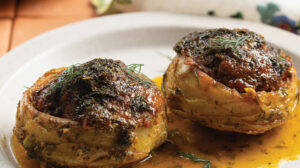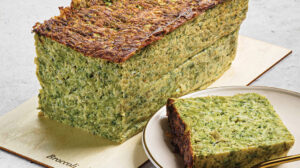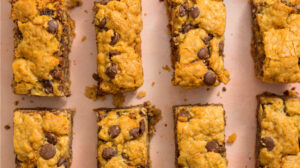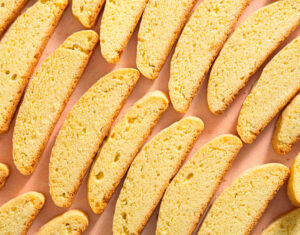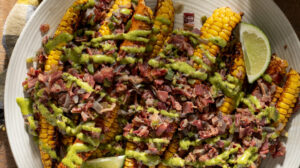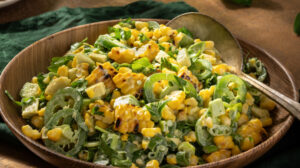Fridge Talk
| July 25, 2023
Let’s talk about the most widely used appliance worldwide: refrigerators. Big, small, drawers, one door, French doors, fridge on top, fridge on bottom… They come in so many versions, and every single home has one!
Over the years I have come to have an intimate relationship with mine, and I absolutely feel possessive over it. To say I am in a relationship with my refrigerator might seem like a stretch, but hear me out. It’s always there for me, will happily accept whatever I put in, never talks back, and occasionally provides the exact comfort food and energy boost required to get through the busy days. It’s opened and closed a hundred times a day, has to store not just the produce and proteins I hope to cook with for dinner (that, spoiler alert, comes daily!!), but also has to store all the condiments I may need to eat dinner with, the leftovers of dinners and Shabbos past, all the milk varieties (sigh for the good ol’ days when milk variety just meant skim or whole), drinks (cans, bottles, big and small), and all the dairy (all the cheese and 400 yogurts in every shape, flavor, and size), while simultaneously staying organized enough that someone who opens it can actually locate what they need.
Now I know what you’re thinking. Ha ha, Danielle, your teenage boys will never be able to find the ketchup. Even if there was a neon sign that read “ketchup” with an arrow pointing to it, they would still need you to locate it for them. And to that I say, fine. You’re right. So really when I say “someone” needs to locate something in the fridge, I mean “me.”
I need to able to use my fridge space well enough to know what I have and use it before it expires. It’s a constant race against the clock.
Refrigerator games.
It’s basically like the Olympic sport of motherhood.
Only it’s way more involved than just swimming a few laps across a pool. We need to successfully stock, organize, maintain, and use its contents efficiently before that expiration date hits. Oh, and also, have on hand everything we need to appease the “I’m staaaaaarving” requests of family members who in absolutely no way are actually starving.
And so, my trusty refrigerator companion, which is set up to help me in all the loyal ways a teammate does, must be loved and tended to in order to reach its potential.
Where to Put It All
Let’s start at the very beginning: An empty fridge.
A truly beautiful sight that I relish at the end of a very long month of Pesach cleaning. Almost to the point that I have to remind myself that the shopping and filling of it is necessary and the forthcoming chaos is truly a blessing.
No matter what kind of refrigerator you are operating with, they all have shelves and a door. Some come with more or less shelves and some have drawers. Those are bonuses.
Before you put a single thing into your fridge, it’s important to understand the cooling zones and how to assign a location to what you put in it so that you can maximize the benefits of the refrigerator.
Heat rises. We all know that. That means that the higher the shelf, the less cool it will be. This makes the top shelf of your fridge ideal for items that need to be cool but will not go bad quickly. That means drinks on top, maybe overflow produce that doesn’t fit in your produce drawer (if you have one), and bread, wraps, and the like.
Oh Danielle, you forgot condiments. They can go there too! Nope! They can’t. And I’ll tell you why.
Condiments, specifically bought condiments, are made to last. They usually have pretty long expiration dates and are made of enough processed ingredients that they can withstand a lot. This makes them the perfect candidate for the door shelves!
As far as fridge space goes, the door is the least secure area of all. Being that it’s opened and closed all day, it takes the longest time to recalibrate itself temperature wise, and although keeping all your milk on the door seems ideal in terms of access, nothing will spoil your milk faster than the up-and-down temperatures of the door shelves.
So condiments, I love you a lot, but you’re going to the door.
Now you have about two to three shelves left on a standard fridge and maybe one or two drawers. The drawers are usually temperature controlled and ideal for produce or dairy. If your refrigerator assigns a category to the drawer, use it for that. It’s literally telling you what its superpower is. To use it for something else would just make it very sad, and we don’t want any sad fridges around here!
Fridge Olympics
Now all you have left to put away are your proteins, dairy, and leftovers.
Some refrigerators have an assigned location for dairy, just like produce. If you have that, stick all your yogurts and cheese in there.
On the bottom open shelf of the fridge, you’re going to put your milk (and dairy if you don’t have a dairy drawer). We want to keep that stuff cold and smelling good for as long as those cartons can last!
After that you have free space on the middle shelf (or shelves) to store your uncooked proteins, leftovers, and whatever odd and ends need to be stored in the fridge.
This sounds like the easy part, but here’s where we go from amateur fridge stockers to fridge Olympians.
You can, on the most basic level, just throw everything in there. You can even buy all the acrylic bins and turntables you want and store it all nicely. But if you don’t fill that fridge with intention, you can fast-forward two weeks to find that leftover grilled chicken you made extra of to have on hand for salads and wraps completely untouched.
So here are my two nonnegotiable gold medal rules:
- No tinfoil in the fridge.
- FIFO.
Before you start booing me, let me explain.
Rule Number 1: No Tinfoil
This is a two-pronged strategy.
Listen carefully. Only food that is easily visible will be consumed. That means that anything wrapped or covered in foil is merely “just visiting” on its way to the garbage. That delicious grilled chicken you made so that your teenager can throw together a salad or sandwich with… useless. Why? Because opening the foil to see what’s in it is too many steps for the “staaaaaarving” person.
Visibility and consumption are directly linked.
The second reason is that we eat with our eyes first.
Tinfoil = leftovers.
If leftovers are your thing, okay fine, move on to the next paragraph. In my experience, though, leftovers are an acquired taste only appreciated with maturity. They’re for the person who paid for the food and understands its value, or for the person who cooked the food who also understands its value. And of course, it’s possible those people are the same person.
However, the people who use the fridge don’t always belong to either category and the idea of leftovers will induce a visceral reaction similar to hearing “I made dog food for dinner.”
Do not fret, though. For us fridge Olympians, hope is not lost. We are older, smarter, more mature, and have many tricks up our sleeves.
In order to maintain our gold-medal status, we must store leftovers in a way that do not make them look like they are “leftover.” This means all leftovers must be transferred to a dish that has optimal visibility and looks nice at the same time.
That means clear Tupperwares or Pyrexes with lids for the win. Bonus points for Pyrex because they can go from the fridge directly into the oven or microwave.
I personally prefer the Pyrex option because of its adaptability to provide storage and a cooking vessel, but this is a personal choice. The only absolute must here is that you purchase items that come with lids! Not only will this help your fridge look cleaner, but the stacking ability provided by the lid is a huge asset in the sport of refrigerator storage.
In order to differentiate between meat, dairy, and pareve, I simply purchase sets with different color lids. It does require an initial small financial investment, but whatever you spend will be repaid in unwasted food and a cheaper tin pan/foil bill!
Rule Number 2: FIFO
This is obvious but often overlooked. First In, First Out.
This means that when you put your groceries away, the new milk cartons go behind the older ones. The new bag of carrots goes beneath the opened bag. The older eggs go on top of the newer eggs. Same goes for the yogurts, bread, and drinks. Whether it has an expiration date or not, everything follows the FIFO rule.
This ensures that all the people who innocently come into your “home office” and start taking things will grab the items that need to be used before reaching for the new stuff. Because, as we all know, reaching is an extra step that, just like with looking beneath the foil, will not happen.
Keep It Clean
Now, once your fridge is set up in the most functional way, it would seem that it’s smooth sailing from here.
Sorry, Charlie.
Nothing will stop a person who took a bottle of ketchup from the fridge door from putting it back anywhere in the fridge that is not the door. This is simply inevitable, and that means there is one final exercise that must be done routinely in order to maintain your gold-medal status.
That is the fridge clean.
Once a week, pick a day, any day (for me it’s Wednesday) that most things come out of the fridge, are taken stock of, and then returned to the fridge in their proper location.
On the weekly fridge clean, you don’t have to remove every single condiment from the doors or reorganize all the shelves. This cleanup is for all the Tupperware, Pyrexes, produce, and dairy items. Remove them, assess what can go back in, along the way return the odd condiment to its proper location, and then restock.
It sounds like a lot of work, but like everything else, once you get into a rhythm and routinely tend to your fridge, this process will take no more than 15 minutes.
Once every three to four weeks the entire fridge should be emptied, shelves and drawers cleaned, and everything returned, but that is a conversation on home-cleaning maintenance and we don’t need to get into it here.
At this point your fridge should be stocked in the most optimal way to preserve the food you put in there and allow you to use it to its fullest potential.
Knowing what you have to work with is half the battle in any cooking endeavor. An organized fridge helps prevent food waste and makes life easier when you open it up to take stock of what you have before you run to the grocery store. Long gone are the days where you open a jar of mayonnaise only to find one half opened in the fridge a day later!
For the busy mom, our refrigerator is our office. It’s where we store our “work supplies” — the food that we hope transfers the love we feel to our family who eats it.
(Originally featured in Family Table, Issue 853)
Oops! We could not locate your form.

